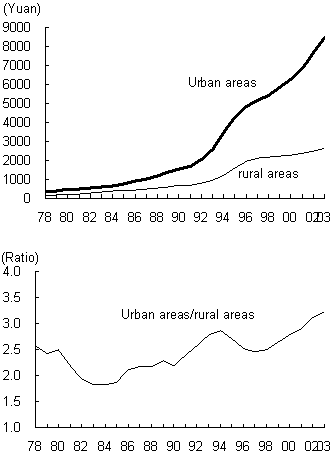China has gained the spotlight as the "world's factory," but we must not forget that it is also a major agricultural country with more than 300 million farmers. However, per capita income in China's rural areas remain at levels about one-third of that in the cities, and when considered together with the various forms of discriminatory treatment that farmers face in such areas as social welfare, the income gap between China's urban and rural areas is the largest in the world. Seeing that this situation may become a cause of social instability if left unaddressed, the adminstration of President Hu Jintao and Premier Wen Jiabao has positioned the resolution of the "three agriculture-related problems" - agriculture, farmers and rural villages - as a matter of top priority since taking office.
The essence of the three agriculture-related problems is that labor productivity and per capita income are extremely low in China due to the excess supply of labor force relative to the endowment of arable land and outdated agricultural technology. In addition, a rigid dual structure of cities versus rural villages has existed in Chinese society since the founding of the People's Republic. Because of this, the social status of farmers is low even today, and their freedom to move is strictly limited by the household registration system. Furthermore, compared to urban residents, not only that farmers do not have such social safety nets as pensions or medical insurance, they are heavily taxed under a wide range of pretexts. Also, even when farmers go to the cities to work, they are discriminated against in many areas such as taxes and their children's education. As this shows, farmers only receive sub-citizen treatment. "Chinese Peasants: An Investigation (Zhongguo nongmin diaocha)," a reportage that vividly depicts this plight of farmers, has become a bestseller and the talk of the town in China ( note ).
In an effort to solve the three agriculture-related problems, for the first time in 18 years the central leadership of the Communist Party of China issued early this year its "No. 1 Circular" (supposed to deliver the most important policy of the year) titled "The View of the Central Leadership and the State Council Regarding Some Policies to Increase Farmers' Income." The State Council issued No. 1 Circulars relevant to the three agriculture-related problems for five straight years between 1982 and 1986, shortly after China started its reform process. These circulars breathed new life into China's farming communities, which had been completely destroyed under the people's commune system. However, since the 1990s, China's farming villages have once again fallen stagnant. Especially, farmers are once again not seeing much growth in income due to the decline in prices of agricultural products brought about by the good harvests of recent years and the increase in imports that accompanied China's entry into the World Trade Organization.
The latest No. 1 Circular includes steps to reduce the financial burden on farmers, such as a cut in the agriculture tax rate and the abolition of the tax on all special agricultural commodities except tobacco. In addition, measures to boost government spending to tackle the three agriculture-related problems, reform the food distribution system and directly subsidize farmers were also introduced. It is estimated that the latest No. 1 Circular will lead to an increase of at least 20 billion yuan in direct income for farmers and an even greater amount of indirect benefits. Chinese media have widely reported these steps, saying that many ideas in this No. 1 Circular have reflected the new administration's stance of sympathizing with the people and deep understanding of the three agriculture-related problems.
However, this alone will not serve as a fundamental solution to the three agriculture-related problems. There are two ways to boost farmers' per capita income. One is to increase farming income, the numerator, and this is what the government has done with the latest steps, which focus on reducing or scrapping taxes on farmers and subsidizing them. The other way is to reduce the denominator - in other words, cut the number of people dependent on farming income. In order to do so, it becomes necessary to shift a majority of China's farmers to nonagricultural sectors such as manufacturing and services.
Despite many restrictions, a mass exodus of labor from rural areas to the cities in search of jobs and more income has already begun. According to a survey report by the Ministry of Agriculture's Research Center for Rural Economy published in March 2004, there were as many as 98.2 million migrant laborers in China. The regions that supplied the bulk of these workers are mostly located in central and western China: Henan Province (13.3%), Sichuan Province (13%), Hunan Province (7.9%), Jianxi Province (5.9%) and Chongqing (5.1%). Meanwhile, the regions that accepted these workers are concentrated along the coast: Guangdong Province (10.1%), Beijing (4.2%), Jiangsu Province (4%) and Shanghai (3.2%). Migrant workers take jobs in such sectors as construction (26.1%), manufacturing (24.3%), restaurants (9.3%), retailing (7.7%) and transport (7.7%). Their average annual income comes to 5,279 yuan (a total of 518.4 billion yuan, or roughly 5% of China's gross domestic product), and 3,768 yuan of this amount, or a total of 370 billion yuan, is sent to their families back home. This is an important part of farmers' income.
As this shows, labor mobility within China does not only help raise farmers' income levels, it also corrects the income gap among different regions and thus serves to greatly contribute to social stability. In order to take this one step further, China must reform its household registration system and allow farmers to move to the cities.
Chart: The widening income gap between urban and rural areas

(Note) Per capita disposable income and per capita net income are used to measure urban and rural income, respectively.
(Source) China Statistical Yearbook


